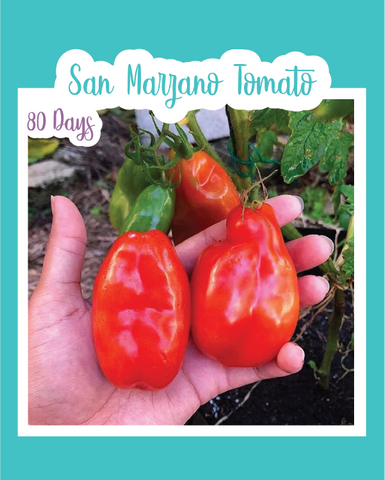
Persimmon Tomato
**THIS ITEM IS SOLD OUT FOR THE SEASON**
Indeterminate
Seed Count: Approx. 20 seeds
Days to Maturity: 80 Days
Description: The persimmon tomato is a delicious heirloom variety originally from Russia. These plants yield plenty of big, meaty, 1 lb, persimmon colored tomatoes. These super productive tomatoes aren't only big in size, but their big in flavor too. They boast a low acidity level, with a relatively small seed cavity. Its flavor is sweet and juicy, with deliciously meaty flesh that are perfect for the classic summer BLT. I adore these tomatoes fresh because they make great slicers in literally every sandwich. Try them in little tea sandwiches (bread, cream cheese and tomatoes); trust me, you won't regret it. Seriously though, it is the best tasting orange tomato I've ever had, and even with the Florida heat they consistently set nice, big, juicy tomatoes, and have earned a permanent spot in my garden.
Mint2Grow Tip: I had these tomatoes in full sun here in South Florida. However, they would've benefited from partial shade when the heat of our summer came around. The plant produced until the end of May (usually my tomatoes start to die off around the beginning of April, since my tomato season is usually from September-March). This variety did attract a good amount of hornworms though (plant with basil to reduce this), and the birds loved to eat it, so I had to keep them well protected. However, it out lived both the pineapple pigs and Mr. stripeys that I grew this season, and I enjoyed their productivity and flavor significantly more. While these tomatoes are not crack resistant, they resisted cracking more than those two varieties as well. While these are amazing fresh, they also taste great cooked in soup.
**THESE SEEDS CAME DIRECTLY FROM MY GARDEN AND MY BE CROSS POLLINATED**
While I do not spray my plants with anything, I can not officially offer these as organic. However, they are organically grown.
How To Grow
Sowing: Start tomatoes indoors 6-8 weeks before the last frost of spring, or direct sow in warmer climates. Sow seeds 1/4" deep and 1" apart. Tomatoes need 70-75 degrees F to germinate, as well as adequate light. Keep the soil moist, but make sure there is proper drainage, or the seeds can rot. When the second set of leaves emerge, transplant the seedlings into individual pots. Bury the stems up to the lowest set of leaves for strongly rooted plants.
Growing: Provide a trellis for this indeterminate tomato, providing extra supports where fruit set. Protect plants, if temperature drops below 55 degrees F, or damage will occur. Keep soil consistently moist, or cracking may also occur. Mulching can be beneficial to preserve moisture, and deter weeds. It is important to avoid wetting the leaves to reduce diseases. You can prune suckers to increase production, (I usually don't bother, due to laziness, but I'll give my plants big trims every month or two once the tomatoes are removed from that section). I surround my tomato plants with basil (it's a great Tomato horn worm deterrent) Other companions include, carrots, garlic, or onions. However, avoid planting them with cabbage, or corn.
Harvesting: Test the ripeness of tomatoes by pressing them gently; the flesh should yield slightly. The mature color also indicates ripeness. If the stem does not come easily off the vine, cut it with a scissors to avoid damaging the vines. Vine ripened tomatoes have the best flavor, but you can harvest them before they fully ripe if pests or weather become an issue. As soon as frost comes, all tomatoes should be harvested, even the green ones. Unripe tomatoes will ripen eventually, if kept in a warm place out of direct sunlight. Seed saving: Since cross pollination between most tomato varieties is unlikely, isolation is not a concern. Pick fully ripe tomatoes and separate the seeds from the pulp, and let completely dry. You can also ferment your seeds to remove the gel like substance on the seeds exterior. During fermentation, any bad seeds will float to the top, and all of the viable seeds stay sunk to the bottom. Fermenting your seeds can also increase germination rates as well. To ferment, squeeze the seeds, along with its gel, into a jar. Add some water, and let it sit at room temperature for a couple of days, you should see a film form on the top, and it should smell a bit sour. Once the film forms, skim it off the top, and rinse out your seeds. Place them on parchment paper to dry. Once dry, store your seeds for the next season.




